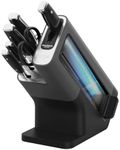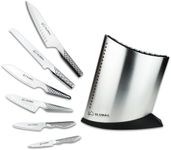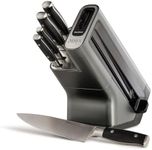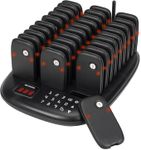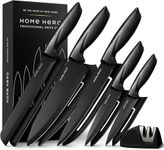Buying Guide for the Best Kitchen Knife Sets
Choosing the right kitchen knife set can significantly enhance your cooking experience. A good set of knives will make food preparation easier, safer, and more enjoyable. When selecting a kitchen knife set, consider the types of knives included, the material of the blades, the handle design, and the overall balance and weight of the knives. Each of these factors can impact the performance and comfort of the knives, so it's important to understand what to look for in each specification.Types of KnivesA kitchen knife set typically includes several different types of knives, each designed for specific tasks. Common knives in a set include a chef's knife, paring knife, bread knife, utility knife, and sometimes a santoku knife. The chef's knife is versatile and can handle most tasks, while the paring knife is great for small, precise cuts. The bread knife has a serrated edge for slicing bread, and the utility knife is a good all-purpose knife. Consider what types of cooking you do most often and choose a set that includes the knives you'll use regularly.
Blade MaterialThe material of the knife blade affects its sharpness, durability, and ease of maintenance. Common materials include stainless steel, high-carbon stainless steel, and ceramic. Stainless steel is resistant to rust and easy to maintain, making it a popular choice. High-carbon stainless steel is harder and holds an edge longer but requires more care to prevent rust. Ceramic blades are extremely sharp and lightweight but can be brittle. Think about how often you use your knives and how much maintenance you're willing to do when choosing the blade material.
Handle DesignThe design of the knife handle impacts comfort and control. Handles can be made from wood, plastic, or composite materials. Wooden handles offer a traditional look and feel but require more care to prevent damage. Plastic handles are durable and easy to clean but may not provide the same level of comfort. Composite handles combine the best of both worlds, offering durability and comfort. Consider the ergonomics of the handle and how it feels in your hand, especially if you spend a lot of time cooking.
Balance and WeightThe balance and weight of a knife affect how it feels and performs during use. A well-balanced knife will feel comfortable and stable in your hand, making it easier to control. The weight of the knife can vary; heavier knives can provide more power for cutting through tough ingredients, while lighter knives offer more precision and agility. Think about your cooking style and preferences when choosing the balance and weight of your knives. If possible, try holding the knives before purchasing to see what feels best for you.
